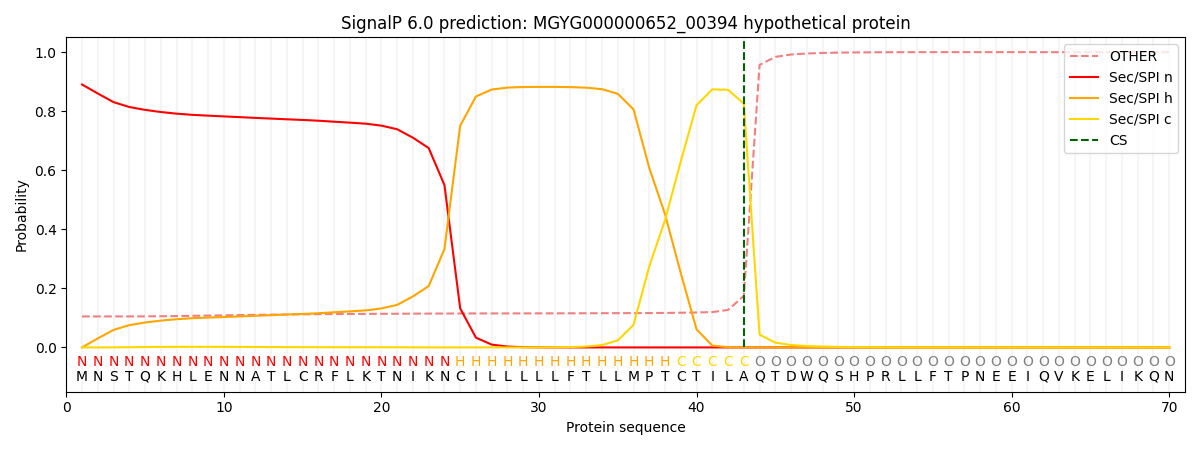You are browsing environment: HUMAN GUT
CAZyme Information: MGYG000000652_00394
You are here: Home > Sequence: MGYG000000652_00394
Basic Information |
Genomic context |
Full Sequence |
Enzyme annotations |
CAZy signature domains |
CDD domains |
CAZyme hits |
PDB hits |
Swiss-Prot hits |
SignalP and Lipop annotations |
TMHMM annotations
Basic Information help
| Species | Bacteroides togonis | |||||||||||
|---|---|---|---|---|---|---|---|---|---|---|---|---|
| Lineage | Bacteria; Bacteroidota; Bacteroidia; Bacteroidales; Bacteroidaceae; Bacteroides; Bacteroides togonis | |||||||||||
| CAZyme ID | MGYG000000652_00394 | |||||||||||
| CAZy Family | PL35 | |||||||||||
| CAZyme Description | hypothetical protein | |||||||||||
| CAZyme Property |
|
|||||||||||
| Genome Property |
|
|||||||||||
| Gene Location | Start: 127386; End: 130349 Strand: - | |||||||||||
CAZyme Signature Domains help
| Family | Start | End | Evalue | family coverage |
|---|---|---|---|---|
| PL35 | 405 | 576 | 1.7e-58 | 0.9776536312849162 |
CDD Domains download full data without filtering help
| Cdd ID | Domain | E-Value | qStart | qEnd | sStart | sEnd | Domain Description |
|---|---|---|---|---|---|---|---|
| pfam00149 | Metallophos | 4.48e-14 | 737 | 937 | 3 | 191 | Calcineurin-like phosphoesterase. This family includes a diverse range of phosphoesterases, including protein phosphoserine phosphatases, nucleotidases, sphingomyelin phosphodiesterases and 2'-3' cAMP phosphodiesterases as well as nucleases such as bacterial SbcD or yeast MRE11. The most conserved regions in this superfamily centre around the metal chelating residues. |
| cd07378 | MPP_ACP5 | 4.55e-08 | 798 | 935 | 75 | 217 | Homo sapiens acid phosphatase 5 and related proteins, metallophosphatase domain. Acid phosphatase 5 (ACP5) removes the mannose 6-phosphate recognition marker from lysosomal proteins. The exact site of dephosphorylation is not clear. Evidence suggests dephosphorylation may take place in a prelysosomal compartment as well as in the lysosome. ACP5 belongs to the metallophosphatase (MPP) superfamily. MPPs are functionally diverse, but all share a conserved domain with an active site consisting of two metal ions (usually manganese, iron, or zinc) coordinated with octahedral geometry by a cage of histidine, aspartate, and asparagine residues. The MPP superfamily includes: Mre11/SbcD-like exonucleases, Dbr1-like RNA lariat debranching enzymes, YfcE-like phosphodiesterases, purple acid phosphatases (PAPs), YbbF-like UDP-2,3-diacylglucosamine hydrolases, and acid sphingomyelinases (ASMases). The conserved domain is a double beta-sheet sandwich with a di-metal active site made up of residues located at the C-terminal side of the sheets. This domain is thought to allow for productive metal coordination. |
| COG1409 | CpdA | 3.66e-07 | 768 | 936 | 40 | 192 | 3',5'-cyclic AMP phosphodiesterase CpdA [Signal transduction mechanisms]. |
| cd00839 | MPP_PAPs | 4.00e-07 | 790 | 975 | 61 | 236 | purple acid phosphatases of the metallophosphatase superfamily, metallophosphatase domain. Purple acid phosphatases (PAPs) belong to a diverse family of binuclear metallohydrolases that have been identified and characterized in plants, animals, and fungi. PAPs contain a binuclear metal center and their characteristic pink or purple color derives from a charge-transfer transition between a tyrosine residue and a chromophoric ferric ion within the binuclear center. PAPs catalyze the hydrolysis of a wide range of activated phosphoric acid mono- and di-esters and anhydrides. PAPs are distinguished from the other phosphatases by their insensitivity to L-(+) tartrate inhibition and are therefore also known as tartrate resistant acid phosphatases (TRAPs). While only a few copies of PAP-like genes are present in mammalian and fungal genomes, multiple copies are present in plant genomes. PAPs belong to the metallophosphatase (MPP) superfamily. MPPs are functionally diverse, but all share a conserved domain with an active site consisting of two metal ions (usually manganese, iron, or zinc) coordinated with octahedral geometry by a cage of histidine, aspartate, and asparagine residues. The MPP superfamily includes: Mre11/SbcD-like exonucleases, Dbr1-like RNA lariat debranching enzymes, YfcE-like phosphodiesterases, purple acid phosphatases (PAPs), YbbF-like UDP-2,3-diacylglucosamine hydrolases, and acid sphingomyelinases (ASMases). The conserved domain is a double beta-sheet sandwich with a di-metal active site made up of residues located at the C-terminal side of the sheets. This domain is thought to allow for productive metal coordination. |
| PLN02533 | PLN02533 | 1.48e-06 | 689 | 937 | 110 | 334 | probable purple acid phosphatase |
CAZyme Hits help
| Hit ID | E-Value | Query Start | Query End | Hit Start | Hit End |
|---|---|---|---|---|---|
| QRP59764.1 | 4.08e-281 | 34 | 621 | 10 | 598 |
| QQT79787.1 | 4.08e-281 | 34 | 621 | 10 | 598 |
| ASM65217.1 | 6.09e-281 | 34 | 621 | 21 | 609 |
| QUU07041.1 | 2.33e-280 | 34 | 621 | 10 | 598 |
| QUT50039.1 | 8.47e-194 | 49 | 619 | 34 | 604 |
Swiss-Prot Hits help
SignalP and Lipop Annotations help
This protein is predicted as SP

| Other | SP_Sec_SPI | LIPO_Sec_SPII | TAT_Tat_SPI | TATLIP_Sec_SPII | PILIN_Sec_SPIII |
|---|---|---|---|---|---|
| 0.110497 | 0.882365 | 0.006168 | 0.000352 | 0.000273 | 0.000324 |

